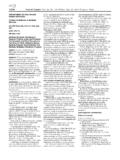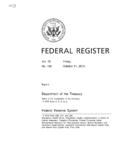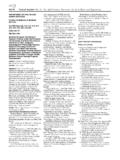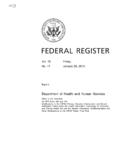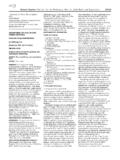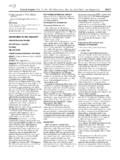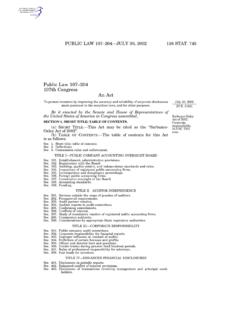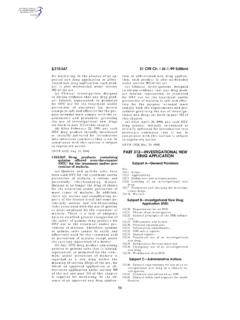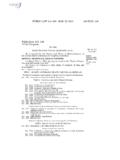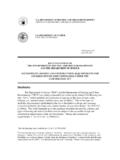Transcription of 7094 Federal Register /Vol. 82, No. 12/Thursday, January ...
1 7094 Federal Register / Vol. 82, No. 12 / thursday , January 19, 2017 / rules and Regulations 1 Mortgagee letters issued under the authority granted to HUD in RMSA will be identified throughout this rule as RMSA mortgagee letters. 2 Mortgagee letters issued under the authority granted to HUD in HERA will be identified throughout this rule as HERA mortgagee letters. DEPARTMENT OF HOUSING AND URBAN DEVELOPMENT 24 CFR Parts 30 and 206 [Docket No. FR 5353 F 03] RIN 2502 AI79 Federal Housing Administration: Strengthening the Home Equity Conversion Mortgage Program AGENCY: Office of the Assistant Secretary for Housing Federal Housing Commissioner, HUD.
2 ACTION: Final rule. SUMMARY: This final rule codifies several significant changes to FHA s Home Equity Conversion Mortgage program that were previously issued under the authority granted to HUD in the Housing and Economic Recovery Act of 2008 and the Reverse Mortgage Stabilization Act of 2013, and makes additional regulatory changes. The HECM program is FHA s reverse mortgage program that enables seniors who have equity in their homes to withdraw a portion of the accumulated equity. The intent of the Home Equity Conversion Mortgage program is to ease the financial burden on elderly homeowners facing increased health, housing, and subsistence costs at a time of reduced income.
3 FHA s mission is to serve underserved markets, which must be balanced with HUD s inherent, as well as, statutory obligation under the National Housing Act to protect the FHA insurance funds. This rulemaking strengthens the FHA Home Equity Conversion Mortgage program and codifies changes that reduce risk to the Mutual Mortgage Insurance Fund and increase the sustainability of this important program for seniors. This final rule follows publication of a May 19, 2016, proposed rule and takes into consideration the public comments received on the proposed rule. DATES: Effective Date: September 19, 2017 .
4 FOR FURTHER INFORMATION CONTACT: Karin Hill, Senior Policy Advisor, Office of Single Family Housing, Department of Housing and Urban Development, 451 7th Street SW., Room 9282, Washington, DC 20410 8000; telephone number 202 402 3084 (this is not a toll- free number). Persons with hearing or speech challenges may access this number through TTY by calling the toll- free Federal Relay Service at 800 877 8339. SUPPLEMENTARY INFORMATION I. Executive Summary A. Purpose of Regulatory Action Since the 2008 housing and economic recession, the HECM portfolio has experienced major borrower demographic and behavioral changes that have caused additional risk to the Mutual Mortgage Insurance Fund (MMIF).
5 Some of the changes include shifting from a predominantly adjustable interest rate mortgage with borrowers receiving payments over time using the line of credit, modified term, or modified tenure payment options to a fixed interest rate mortgage with borrowers drawing large amounts of HECM proceeds at the time of closing; younger borrowers with higher amounts of property indebtedness; and increasing property charge defaults. While program changes made prior to and during 2013, such as consolidating the HECM Standard and HECM Saver products, did improve the stability of the HECM program, the HECM portfolio has continued to experience volatility.
6 The economic value of the HECM portfolio has fluctuated from a negative $ billion reported in FHA s Fiscal Year (FY) 2014 submission to Congress, to a positive $ billion in FY 2015, to a negative $ billion in FY 2016. Even under an improved housing market, the positive impacts of program changes on the HECM portfolio overall will be gradual and initially difficult to model for purposes of the actuarial study, as they will be evidenced only in future cohorts of activity. As a result, it is critical to remain vigilant in monitoring program performance and policy to ensure the soundness of the MMIF.
7 Recognizing the need to stabilize the HECM program and ensure it remains a sustainable program, Congress passed and the President signed into law, the Reverse Mortgage Stabilization Act of 2013 (RMSA) (Pub. L. 113 29). The RMSA gave FHA the tools to make, through mortgagee letter,1changes to the HECM program that are necessary to improve the fiscal safety and soundness of the program. Under this authority, FHA implemented a number of changes to the HECM program, including the Financial Assessment and Property Charge Funding Requirements; deferring the due and payable status for Eligible Non-Borrowing Spouses; limiting disbursements during the first 12 months of the HECM; and eliminating future draws on fixed interest rate HECMs.
8 On May 19, 2016 (81 FR 31770), HUD published a proposed rule to codify these policies, with amendments as discussed in the preamble to the proposed rule. In addition, FHA proposed to implement a number of new policies. Also, so that all regulatory requirements are codified in the HECM regulations, HUD also proposed to codify HECM program changes made by mortgagee letter2under the Housing and Economic Recovery Act of 2008 (HERA) (Pub. L. 110 289), which implemented the HECM for Purchase program and established new origination fee limits, and amends the initial and monthly mortgage insurance premium (MIP) limits to correspond with statutory changes.
9 This final rule follows publication of the May 19, 2016, proposed rule and takes into consideration the public comments received on the proposed rule. B. Summary of Major Provisions of This Final Rule In this rule, FHA codifies existing policy which has been implemented by mortgagee letters under various statutory authorities; implements statutory changes; issues new origination and servicing policies; and clarifies existing regulatory language. The main policy provisions are discussed below. All policies which have been implemented by mortgagee letters will remain in effect until the effective date of this final rule.
10 Implementing Statutory Changes and Codifying Existing Policies Implemented Under Statutory Authority Financial Assessment and Property Charge Funding Requirements. RMSA Mortgagee Letter 2014 21 required mortgagees to perform a Financial Assessment of the prospective borrower prior to loan approval, which considers the prospective borrower s credit history, cash flow and residual income, extenuating circumstances, and compensating factors. Based on the results of the Financial Assessment, the mortgagee may require a Life Expectancy Set Aside (LESA) for the payment of certain property charges. For fixed interest rate HECMs, if a LESA is required, it may only be a Fully-Funded LESA.
